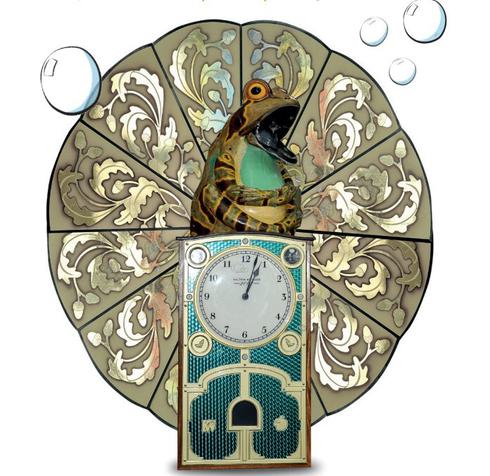The Time Machine 'Frog Clock’
A combination of illusion and fantasy within a glorious timepiece.



Weighing in at an epic four tonnes, ours is one of the largest animated clocks in the UK - no wonder it took Kit Williams two whole years to build! But there’s even more to this giant clock than meets the eye…
Every few minutes a glistening ball is transported to the clock’s cabinet along a 16 metre long gantry. Impressive enough. But to see something extra special, be patient. Because every half-hour these golden deliveries prompt the giant frog sitting on top of the clock to come to life, playing music and blowing bubbles for all around to catch.
Where does this never-ending stream of golden balls come from?
Nobody knows. Not even the frog!
The history:
In the late 1970’s, Gloucestershire artist Kit Williams transformed Britain into a giant treasure map, promising an 18-carat golden hare, buried in the earths soil, to the first person who solved the riddle of his book- Masquerade, which had sold 2 million copies worldwide.
The frenzy that followed the hunt drove Williams to his studio near Stroud, where he has continued to create complex and beautiful art.
Kit is the not only the man behind our much-loved Time Machine ‘Frog Clock’ but also the man behind several Gloucestershire works of art- namely The Dragonfly Maze in Bourton-on-the-Water, The Wishing Fish Clock in Cheltenham's Regent Arcade, and the Lady and Tiger Illusion Clock which used to be on display in the town's Beechwood Shopping Centre.
Stained-Glass Window

A striking feature within the centre is the colourful stained-glass window created by renowned stained glass artist Anne Smyth.
The stained-glass design gives a unique portrayal of Milton Keyne’s famous highway grid system. The designs were developed from a mix of architectural models of the area from the 1970s, roman mosaics, local landscape, and local history.
When the sun shines, coloured light floods into the shopping centre!
Sitting on History Bench:

‘Sitting on History’ is an abstract sculpture, sculpted by Bill Woodrow, that we proudly have situated in our Shopping Centre, right outside of Waterstones!
Woodrow’s idea was to have a sculpture that was only completed conceptually and formally when a person sat on it. In ‘Sitting on History’, the viewer takes a seat on the very pages of the book.
‘Sitting on History’, with its ball and chain, refers to the book as a receptacle of knowledge on which history is written, disseminated, and studied. History is filtered through millions of pages of writing, making the book the major vehicle for research and study.